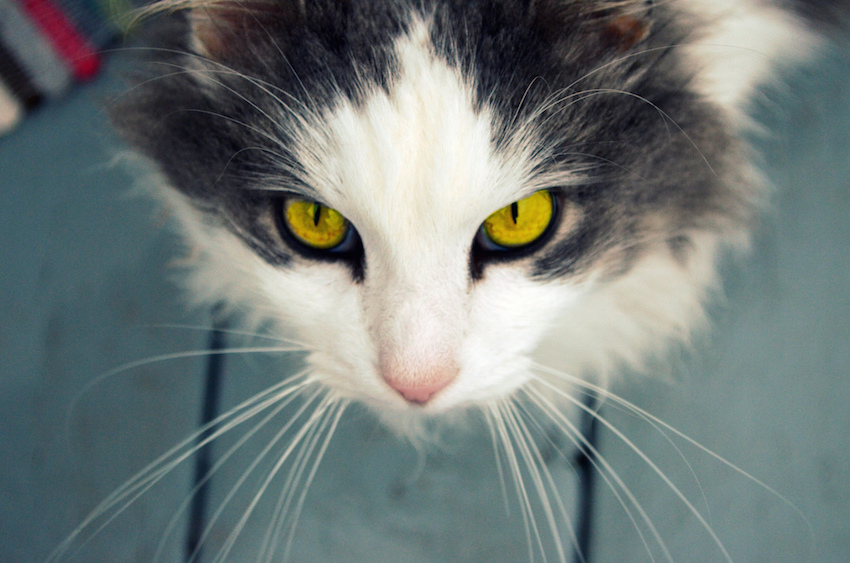Petful is reader-supported. As an affiliate of platforms, like Amazon, we may earn a commission when you buy through links on this page. There is no extra cost to you.
Whether the patter of tiny paws is planned or not, it’s important to take care of your cat when she is pregnant. Indeed, learning how to care for a pregnant cat is not as complicated as it may seem.
A healthy pregnancy means a high chance of straightforward birthing, which is good news for mama cat, the kittens — and your blood pressure.
So, what to expect when your cat is expecting?
In this expert guide to pregnant cat care, we’ll discuss:
- How long a cat stays in heat
- How to identify a cat’s heat cycle
- What you can do when your cat goes into heat
- How to tell if your cat becomes pregnant
- Your cat is pregnant — now what?
- What to expect during your cat’s pregnancy, from the first 6 weeks to the final 3 weeks
- How to feed your cat optimally during her pregnancy
- Potential cat pregnancy problems and how to spot them
- What to do if your cat refuses to feed her kittens
- Why there’s a very small chance your cat will reject her kittens outright
- Postpartum depression — yes, cats can get it too
- And what to expect, week by week, as the kittens grow
Ready? Let’s get started with our pregnant cat care guide!
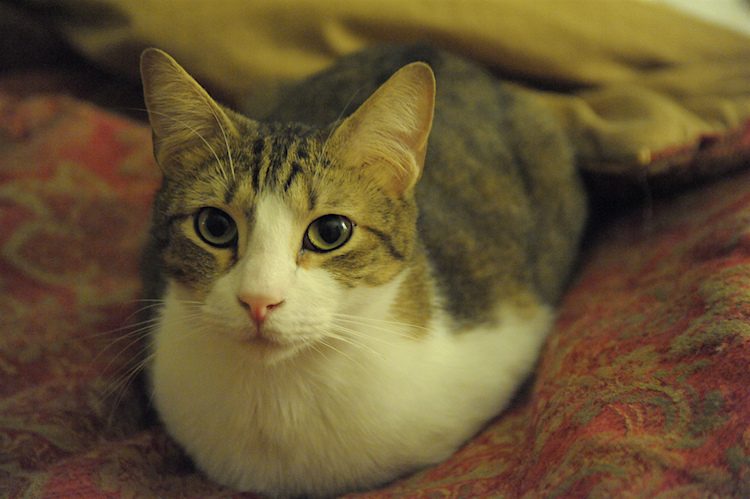
Part 1: How Long Do Cats Stay in Heat?
Cats stay in heat for 4–10 days.
This cycle can happen every 3 weeks.
A cat’s first heat cycle, called estrus, happens at sexual maturity — which, depending on the breed, could be when the kitten is anywhere from 5 months old (for Siamese cats, for example) to 10 months old (particularly for some of the longer-haired breeds, such as Persians).
As a result, many people spay their cats as soon as possible so their cats don’t experience a heat cycle. Of course, spaying also helps prevent pet overpopulation.
How to Tell When Your Cat Is in Heat
You might expect bleeding when a cat goes into heat, but that’s not usually the case.
Although a small amount of bleeding and discharge may occur, it is not common. The changes are more behavioral.
Here are some ways a cat’s behavior may change when she goes into heat:
- More affectionate
- Rubbing against people or objects
- Rolling on the floor
- Demanding more attention
- Raising the hind quarters when rubbed or scratched
- Becoming vocal, even yowling at times
- Urinating more frequently or marking on objects
- Trying to escape to the outdoors
This video shows a cat in heat meowing to a male cat. Grab some ear plugs:
Urinary markings serve a purpose to other cats:
- The pheromones and hormones released in the urine indicate the female cat’s reproductive status.
- The scent can be so strong at times that you may notice male cats hanging around outdoors even if your cat is an indoor pet.
What Can You Do When Your Cat Goes Into Heat?
Have your cat spayed to prevent reproduction. You can spay as early as 8 weeks of age, but check with your veterinarian.
If a cat is already in heat, some vets may wait until the cycle is over before performing the spay.
Remember:
- Cats do not need to have a litter of kittens before they are spayed.
- Reproducing does not make them more affectionate, alter personalities or solve any problems. It does add to pet overpopulation.
- Cats can become pregnant during their first heat cycle, and they do not discriminate when it comes to finding an available male — they will mate with their parents or siblings.
- Cats can go back into heat soon after giving birth.
Some More Cat Pregnancy Facts
- Cats can skip a heat cycle and may even show signs of pregnancy without being pregnant (false pregnancy).
- Family members can and will mate if they have access to each other. It’s not about being brother and sister that matters to cats; it’s just about having the right equipment.
- Naturally aborted fetuses may be eaten by the mother.
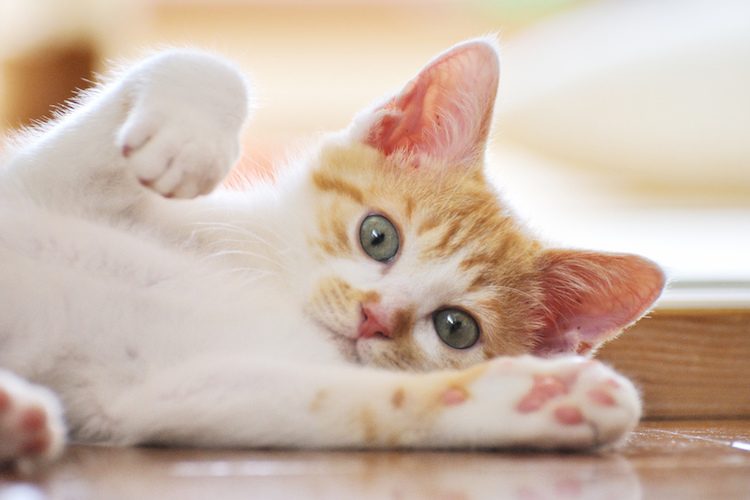
Part 2: How Do I Know If My Cat Is Pregnant?
If you have a female cat who has not been spayed, chances are you are familiar with the heat cycle that occurs and how frequently your cat experiences it. However, knowing how to tell if a cat is pregnant can still be tricky.
A break in your cat’s heat cycle might mean she is pregnant, but there are other symptoms that can be signs of an impending arrival of tiny kittens.
Symptoms of Pregnancy in a Cat
Besides the heat cycle changing, your cat may have recently been outside, escaped or been around a male cat (tom cat) who wasn’t neutered.
If you suspect your cat is pregnant and are wondering, “How can I test my cat’s pregnancy at home?” observe them to see if you notice any of these signs of pregnancy in cats:
- Swollen pink nipples (usually the earliest sign)
- Sleeping more
- Increased appetite
- Vomiting (some is normal, but excessive vomiting requires a trip to the vet)
- Abdomen increases in size or belly starts hanging lower
- More affectionate
- Weight gain (a pregnant cat belly)
- Seeks out quiet and/or secluded areas for birthing (closer to the end of pregnancy)
Your vet can examine the cat and confirm pregnancy by feeling the abdomen carefully and performing an ultrasound or hormonal test.
My Cat Is Pregnant. Now What?
Once you’ve confirmed the pregnancy, you’ll need to decide what to do based on how far along the cat is in her pregnancy:
- For an unplanned pregnancy in your cat, one option is to terminate the pregnancy. Discuss this with your vet.
- The other option is to allow your cat to go to full term and deliver the kittens.
If you decide to allow the pregnancy to go to term, make arrangements for the kittens’ care in your home or contact local shelters or rescues to make arrangements. Taking care of a pregnant cat is the first step, learning what to expect after a cat gives birth is also important.
Assuming you’ve had the vet checkup and have discussed vaccinations and medical concerns, you’ll next need to look at dietary needs.
Your pregnant cat needs a nutrient-rich diet during her pregnancy and fresh, clean water at all times.
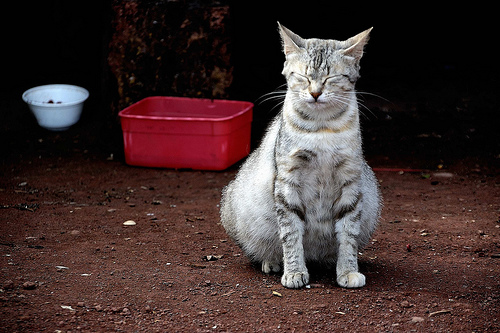
Part 3: Pregnant Cat Care: What to Expect
When the mating is planned, you have the luxury of getting your girl in good shape. Here’s more on what to expect when preparing for cat pregnancy.
Before your cat becomes pregnant, make sure she is up to date with:
Remember, this isn’t just about protecting her — it’s also about protecting the unborn kittens.
For example, vaccination means the mother gives the kittens protective antibodies in her milk, while fleas suck blood, which can cause serious anemia in newborn kittens.
Another crucial factor is the mother-to-be’s weight. You’ll want her to be lean to normal rather than normal to well-covered.
If the cat is overweight or obese, then postpone the plan until she’s safely dieted to a healthy weight — the risk of birthing difficulties rises dramatically in mom cats who are overweight in early pregnancy.
Pregnant Cat Care: The First 6 Weeks
So, how long are cats pregnant for? Well, pregnancy in cats lasts about 9 weeks (64–67 days).
This is best divided in 2 unequal sections: the first 6 weeks and the final 3 weeks.
Feeding the Mother
Avoid the temptation to start bulking your cat up.
One of the biggest mistakes is “feeding the unborn kittens” too early.
Feed the mom normally for these first 6 weeks. This doesn’t mean starving her if she’s hungry, but don’t deliberately ply her with more food than she’s used to:
- If she’s not looking for extra food, then stick with the same portion size and frequency.
- If she seems hungry, then fair enough: Give her a little extra, but keep a firm eye on her body condition.
We don’t want her to lay down extra fat right now. Check this out by feeling for her ribs. You should be able to feel the gentle ebb-and-flow of her ribs, but individual ribs shouldn’t be staring out at you.
Here’s a handy list to keep in mind when it comes to feeding a pregnant cat during the first 6 weeks:
- Unable to feel her ribs because there’s fat in the way? Don’t up her ration.
- Her ribs are felt as gentle bumps? She’s doing great.
- Obvious ribs? OK, let her have a little more food.
The Mother’s Health and Well-Being
Keep up with Mom’s routine preventive health care, but check the packaging. Not all preventives are licensed for use in pregnancy, so carefully read the packet insert before applying or dosing. If in doubt, call your vet for advice.
Also, let her set the pace. If she wants to play, then let her. She needs to stay fit and in good condition ready for the birth.
Pregnant Cat Care: The Final 3 Weeks
Feeding the Mother
Now is the time your pregnant cat needs more nutrition.
But it’s also when the kittens are getting big and squashing her stomach, making it hard for Mom to eat large meals.
So feed her kitten food in lots of small meals spaced over the day. The stomach pressure will make her unlikely to overeat, so give her the amount she can clear at each sitting.
Preparing for Birth
Now is the time to provide a nesting box and get your cat used to it so it’s a “go-to” spot when she goes into labor.
Also, plan ahead and get a birthing kit ready. This should include a flashlight (for peering under the bed), paper and pen (to note down timings) and the vet’s phone number (for advice).
And last but not least: Chill.
Try not to stress so she can have a peaceful pregnancy and smooth birth.
Potential Cat Pregnancy Problems
Not every pregnancy in a cat goes as planned, and there are some risks involved that you should be prepared to address with a trip to the nearest animal emergency facility.
- Eclampsia is a life-threatening condition with symptoms such as restlessness, pacing, panting, drooling, loss of coordination, muscle spasms or seizure-like movements.
- Secondly, the fetuses can abort naturally. Signs that this may have happened may include fever, bleeding, behavioral changes or other changes.
- Lastly, resorption occurs when the mother’s body absorbs the dead fetus.
Any of these situations are serious and need to be addressed by a vet immediately.
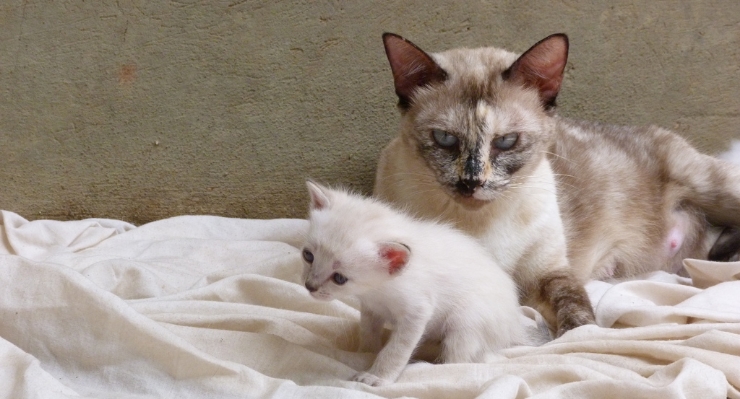
Part 4: What to Do When a Cat Refuses to Feed Her Kittens
We think of cats as being excellent mothers.
By and large, that’s true. But occasionally, a cat does come along who won’t nurse her kittens.
Reasons Why a Cat Refuses to Nurse her Kittens:
- A first-time mother cat might be overwhelmed.
- Or, if the litter is large, she might not have enough milk for all those kittens.
- Sometimes a female cat, just like a human mother, comes down with mastitis (mammary gland inflammation).
- Or the problem could be, as breeder Susan Graham points out, a retained placenta. “You have to look at everything and not forget mama cat,” she says.
Occasionally, it is a behavioral thing. Like Winifred Carriere’s Siamese cat named SuziTu, she might be focused on just 1 or 2 of the kittens.
Carriere writes in her book Cats, 24 Hours a Day that SuziTu seemed to think that “the first baby was the only one, for as each of the 5 was born, she industriously licked the first (comparatively) big bruiser … while he eagerly sought and found his first meal.” His siblings could, as far as Mama Siamese was concerned, “shift for themselves.”
Except for Kitten No. 5, whom the mama cat clearly regarded as “excess baggage.”
Carriere had to come to the rescue with an eyedropper filled with milk. (Note: Carriere’s book was published in 1967, and vets today strongly advise against giving cow’s milk to newborn kittens on a long-term basis.)
In time, SuziTu got a handle on being a mom and accepted the “little-last-on-the-list.”
Not Prime Mom-Cat Material: An Example
Graham, whose Aksum Cattery is located in Atlanta, has heard plenty of stories about cats who have fallen off the mommy track.
She herself had one mom cat who had no intention of getting on that track in the first place.
“I had to literally hold her down so that the kittens could nurse several times a day,” the breeder recalls. “She had plenty of milk, but she wouldn’t stay with them at all.”
Graham ended up “petting out” the Persian. “That kind of thing tends to be hereditary,” she remarks. “At least, I’ve noticed that really good mothers tend to have kittens.”
And she suspects that the same holds true with the less-than-stellar mother cats and their daughters.
What You Can Do When Your Cat Refuses to Feed Her Kittens
Sometimes you can find another female cat to substitute for your mom cat who refuses to feed her kittens.
“If they’re here, a lot of times, we’ll have a nursing female that will take care of them,” says Dr. Thomas Morganti, DVM, of the Avon Veterinary Clinic in Connecticut.
If that’s not an option, he recommends KMR Milk Replacer for Kittens every 2 hours for the first 2 weeks.
Graham favors tube-feeding her kittens a “formula that I make myself from concentrated goat’s milk, unflavored Pedialyte and a few other things.” Cow’s milk and human baby formula can be used — but only in a pinch.
Smaller, more frequent feedings will keep the kittens’ digestive systems and kidneys from being overloaded. Diarrhea is a sure indication that you’re over-feeding them.
Step up the feedings if your kittens are shivering and not gaining weight. Underfed kittens tend to be listless and cry all the time.
Once the Rejected Kittens Are Off the Bottle
Around weeks 4–7 is a “critical time” in the kittens’ socialization, says Morganti.
“The danger is, by the time they’re weaned, you don’t want to deal with them,” he says.
“You have to fight that tendency. You can’t just ignore them. You have to give them lots of handling and play. If they don’t get that, they can be worse than feral.”
Taking care of a pregnant cat doesn’t stop after birth. Now there is a litter of kittens to consider and care for, especially if the new cat mom behavior becomes neglectful.
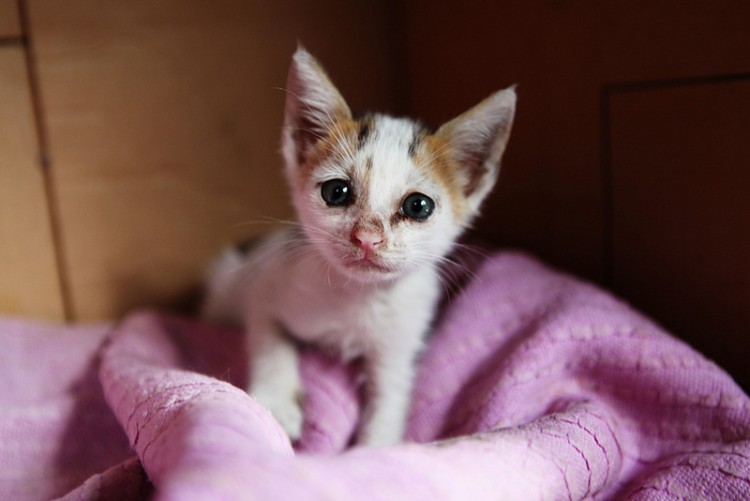
Part 5: When Mama Cats Reject Their Kittens
One of the most heartwarming sights imaginable is that of a cat blissfully kneading the air while her newborn kittens nurse.
“Most cats are naturally good mothers,” writes Betty Lewis. “In most cases Mom will provide pretty intensive care for her babies during the first 3 weeks of their lives, when they’re at their most vulnerable.”
So, if you come across kittens without their mother, don’t automatically assume that the mom cat has rejected her kittens and abandoned them.
It’s a good idea to become familiar with new mom cat behavior after giving birth, because caring for your cat after pregnancy is still a part of the pregnant cat care process.
What To Do if You Find a Kitten Alone
Cat moms are always on the lookout for new hiding places. Also, they’re more inclined to take breaks as their babies get older. This is true of most stray and feral mothers, too.
Do not scoop the kittens up right away.
“If you move the kittens,” Lewis says, “she won’t be able to find them when she returns.”
So, wait. And check that the kittens are “basically clean, alert (or sleeping contentedly) and nestled close together,” Lewis says. “This is an indication that Mom is in the middle of important business and that she’ll be back soon enough.”
But if the kittens look scrawny, sickly and not groomed, the odds are good that something has happened to Mama.
Then and only then do you step in.
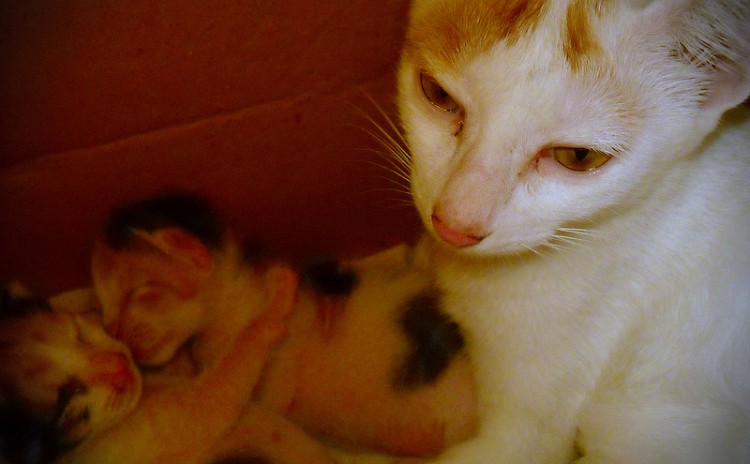
Why Do Cats Reject Their Kittens?
Sometimes it takes time for the maternal instinct to kick in.
One cat, Safra, “became extremely anxious while the kitten was being born and after it was delivered,” explains her human, Claire Forrest.
“She was not able to attend to it immediately. Although she looked at it and licked it momentarily, mostly she was pacing, trying to get out of the crate and looking to me with a pleading expression.”
Within 35 minutes, however, Safra had begun tending to her kitten and “behaving like a very caring, attentive mother.”
Forrest believes that Safra’s anxiety and confusion over her baby were “fueled by the intense hormonal changes that occur during and after giving birth.”
Anyone dealing with a cat giving birth should be prepared for the unexpected and have Bach’s Rescue Remedy and Zylkene on hand. Both are proven stress relievers.
Why Do Mama Cats Kill Their Kittens?
Yes, occasionally, female cats do kill and even eat their kittens.
Mom cats will sometimes do this if they think there’s some danger threatening their kits.
According to cat expert Sarah Hartwell, it is “a frustrated protection instinct. Unable to protect her kittens against a perceived threat, she kills them in a futile attempt at protecting them.”
Inexperienced mother cats are more likely to do this. They get frightened and take the kittens into their mouths to protect them, inadvertently swallowing them.
There’s also the myth that cats will kill their kittens if humans handle them. Disregard it. Mother cats will move their kittens if this happens, yes — kill them, no.
Handling kittens as soon as their eyes are open is actually a good idea — it helps with their socialization. But don’t let children handle the kittens. They may not realize how fragile the babies are.
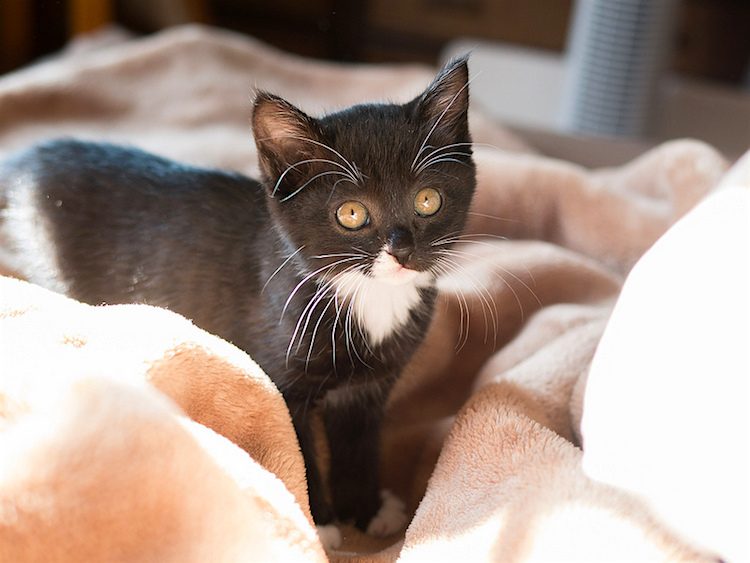
Part 6: Motherhood and Postpartum Depression in Cats
River doted on her newborn kitten, and Li’l One grew bigger and more beautiful.
Then, around 4 weeks later, Kathie, River’s human, found a gaping wound on the back of the kitten’s neck. Li’l One went to the vet, was treated with antibiotics and was separated from her mom.
Kathie and the vet did everything they could to save the kitten. But the infection had gone too deep — Li’l One died at the end of the week.
River grew depressed. She didn’t understand why her baby had been taken from her or her part in it. The humans involved didn’t understand it completely themselves. River had been such a loving mom to Li’l One in the beginning.
What had driven this mama cat to harm her kitten?
Good Cat Moms
John Bradshaw writes in his book Cat Sense that “many female cats, especially those with kittens, seem not to distinguish between their offspring and those of other cats with whom they are already friendly.”
He says that in the wild, these other cats “are most likely their own daughters and sisters — cats they have known and trusted their entire lives.”
These female cats work together for the common good: the kittens who will keep their tribe/particular genes going:
- The queens strive to find “the best sites for dens in which the kittens can be born and to stay as close as possible to the best places to find food.”
- And they fight off marauding tomcats.
Only problem? Not all female cats have that strong maternal urge.
Or sometimes, as in River’s case, something happens to it.
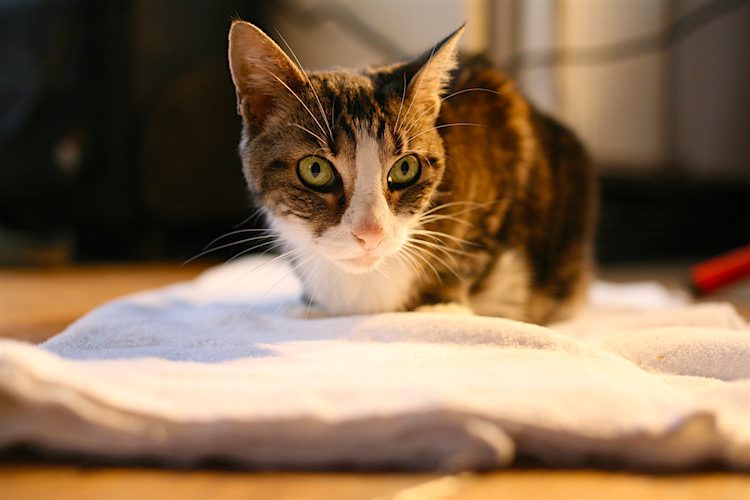
The Maternal Urge
We heard a story about how one recently rescued feral cat abandoned her kitten at birth. The kitten was unusually large, and there was a lot of blood. Presumably, the birth was a traumatic one.
Or maybe she was simply played out (this was not, we had been told, her first litter). All we know is that she looked at that kitten with total indifference.
Some cats will take it up a few notches and kill and/or eat their kittens.
As cat expert Sarah Hartwell points out, there could be something wrong with the kittens, and “the mother simply does not want to waste time or energy in raising kittens that have little chance of survival.”
In addition, the cat “may eat all or part of some of these kittens in an attempt to recoup some of those losses (just as she eats placentas) and to dispose of ‘carrion’ that could potentially lead predators to her nest,” Hartwell says.
Don’t think that this just happens with feral or barn cats. The breeders of purebred cats sometimes find themselves confronted with the same issue and have to separate kittens from their moms as early as 3 weeks.
Can Cats Get Postpartum Depression?
There’s not much written on the subject of postpartum depression in cats.
As someone pointed out in an online discussion, we still don’t “really understand it in humans…. Whether animals can suffer postpartum depression depends on how you define postpartum depression. Technically speaking, the current clinical definition only applies to humans, so a clinician’s answer would be ‘no.’”
But one woman in the same forum talked about how her affectionate young female cat turned into a little ghost-cat after her kittens were born: “I can’t give her a cuddle now, she just walks away … or hear her purr, just feel it in her chest.”
Another person who worked in a shelter had dealt with a mother cat who “went from very sweet to psycho kitty” in nanoseconds, and this was after her kittens had been taken away so that they could be socialized. The cat’s hormones finally settled down after spaying, and she reverted to “her sweet self.”
After losing her own babies, this cat adopted rescued kittens:
Dr. Thomas Morganti, DVM, of the Avon Veterinary Clinic in Connecticut doesn’t see why postpartum depression should apply only to humans.
“As the kittens are weaned, the oxytocin levels drop because the mother’s not nursing anymore. And oxytocin is ‘the hormone of love,’” he says.
He believes that postpartum depression “happens in all species. It’s just that the changes are subtle. Somebody else might not notice it, but you might in your own cat.”
It would also explain River’s behavior, Kathie feels.
“You find a lot of women suffer from postpartum depression in different degrees. I’m sure cats suffer it, too,” she says. “The hormones are there. Where do they go? Something has to happen to them.”
River, like the shelter cat in the discussion group, has mellowed considerably since her milk dried up and is more like “the sweet, lovable, not-so-needy cat” that she was before Li’l One’s birth. “She’s out of her funk,” Kathie says.
We make a lot of assumptions about feline behavior, and this is one area that really calls out for exploring.
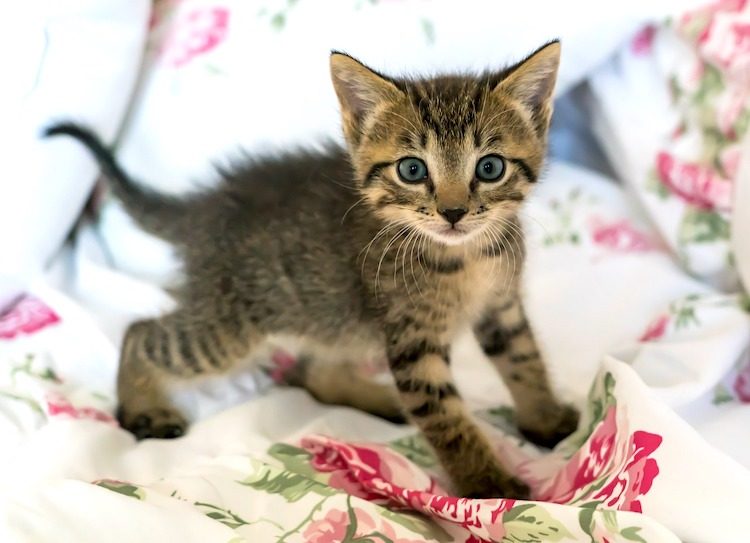
Part 7: Kitten Development Stages — What to Expect
Your cat just had kittens and you’re thinking, “Now what?”
Kittens go through rapid development for the first 12 weeks and will require attention, veterinarian visits, socialization and much more.
Review the week-by-week details below to find out how the kitten development stages progress and what your responsibilities will include.
Kitten Development Stage: Week 1
- Kittens are born with their eyes and ear canals closed. They do not have any sight or hearing and will most likely stay close to the mother.
- The umbilical cord will dry up and fall off within a few days.
- Their main activities will include eating, sleeping and passing waste.
- The mother cleans the kitten regularly, and this also helps stimulate the newborn.
Kitten Development Stage: Week 2
- The kittens’ eyes will begin to open, but vision will be blurry.
- They will start to develop a sense of smell.
Kitten Development Stage: Week 3
- The kittens may have blue eyes at birth, but this will change as the kitten ages. You may start to see this change in the third week.
- Hearing begins and starts to improve, and you may notice that loud or abrupt noises scare the kittens. Because of the change in hearing, their ears will begin to stand up.
- The sense of smell continues to improve, and the kittens will begin to pass waste without prodding from the mother.
- Teeth may start coming in this week, and purring may commence.
- Your kittens may also go mobile and start walking this week.
This video shows some little ones at 3 weeks into their kitten development stages:
Kitten Development Stage: Week 4
- The kittens will start working on balance and will walk more. The head is usually large compared to body size, so your kittens may be wobbly while moving around.
- They will begin to explore their surroundings, and you may find yourself on the hunt. Kittens usually stay close to the mother, though.
- Evaluate any harmful items, chemicals, plants or small openings to minimize risk to the kittens. They will still be nursing at this time, and you can start introducing them to the litter box. Don’t be afraid if the kitten tries to eat the litter — this is normal. Accidents are expected.
Kitten Development Stage: Week 5
- This is a great week to start socializing and bonding with your kittens. They start moving around more and will start to play.
- They will still be nursing for a few more weeks, but you can introduce canned food made for kittens.
- If you haven’t already, introduce the kittens to the litter box. You will need to provide a smaller box with less litter than in the adult cat’s box.
Kitten Development Stage: Week 6
- If you choose to give a worming treatment as a precaution, you’ll usually want to do this in the sixth week.
- You will notice your kitten is more playful and constantly on the move, and may even start scratching different surfaces to sharpen the nails. This would be a good time to implement a scratching post to teach the kitten where this behavior is allowed.
Kitten Development Stage: Week 7
- Vet trip! Vaccinations are typically started in the seventh week.
- The kitten will be more active and playful, and you should see an improvement in coordination.
- This week is also a good point to introduce the kitten to grooming. Use a brush on the kitten, give them a bath (make sure not to get soap in the eyes, ears or nose, and dry thoroughly) and start handling the paws regularly.
- If the kitten gets used to their paws being handled, this will make nail clipping much easier in the future.
Kitten Development Stage: Week 8
- No major changes happen this week.
- The kitten will continue to be active and social with other kittens or the mother.
- Continue practicing grooming and getting the kitten adjusted to their paws being handled.
Kitten Development Stage: Week 9
- The weaning process should be finished and the kitten eating provided food regularly.
- Play time and human interaction should be high this week.
Kitten Development Stage: Week 10
- The nails should be long enough (and probably sharp enough) by now to start trimming.
- If you administered worming treatment, this is the week for the second application.
Kitten Development Stage: Week 11
- Vet trip! The second set of shots are needed this week.
- The kitten increases playing and socializing time.
Kitten Development Stage: Week 12
- This week usually involves another vet appointment for a rabies shot (if applicable).
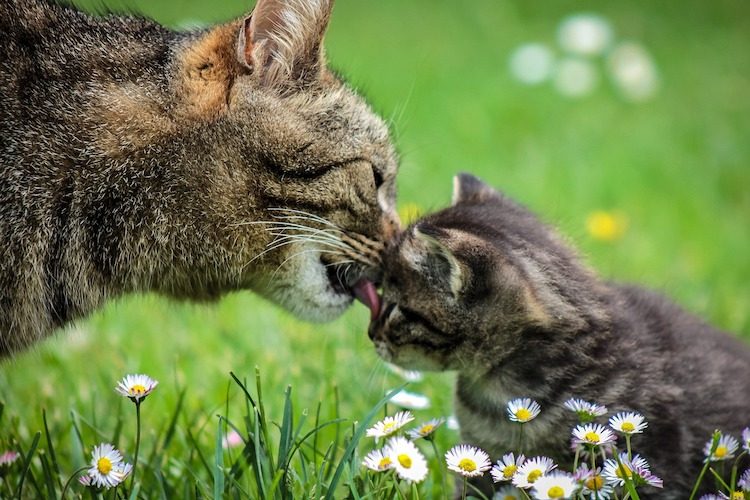
What to Expect in the Weeks Ahead
Your kitten should continue to grow in size and weight each week, but contact your vet if you notice a lack in either area.
Make plans to spay or neuter your kitten around the 6-month mark, although some vets perform this operation based on weight or after 2 months. Exact weeks vary for worming treatments, so check with your vet for a recommendation.
If you notice fleas on your kitten, don’t rush to treat them with chemicals. Review our instructions for flea removal for kittens.
Start to adjust your home to more kitten-friendly. Always supervise your kitten around other pets and people, and plan to cover wires and small access areas (like the attic) to ensure your kitten won’t be harmed or stuck in a poorly ventilated area.
Frequently Asked Questions (FAQ)
How Do I Tell How Far Along My Cat Is?
It can be hard to tell how far along your cat is in her pregnancy. If you notice some of the aforementioned signs of pregnancy in cats, like changes with their nipples, weight gain (especially in the stomach area), and behavioral changes, then taking her to a vet to assess her can help you determine a precise timeline.
How Do I Know When My Cat Is About to Give Birth?
If you have an idea of your cat’s pregnancy timeline then it can be easier to track when they’re likely to be due. It’s probable that your cat will begin showing signs that labor is starting through changes in her behavior. A decreased appetite, irritability, being more vocal than normal, and contractions and discharge are just some of the signs that could indicate your cat is ready to give birth.
How Many Kittens Can a Cat Have?
The amount of kittens a cat can give birth to in one litter can vary. On average, it’s usually around four to six kittens, but that amount can certainly fluctuate depending on various factors. Additionally, a cat’s first litter is usually on the smaller side and then can increase in subsequent pregnancies.
When Can a Cat Get Pregnant?
A cat can get pregnant during their first heat, which typically occurs when they are about 5 months old. However, each cat is unique and factors like breed can affect when a cat goes into heat, which in turn influences their ability of getting pregnant.
References
- Eldredge, Debra, Beth Adelman and Delbert G. Carlson. Cat Owner’s Home Veterinary Handbook. Wiley Pub., 2008.
- Caplan, Morton B. and Linda Ostrowalker. The Pet Doctor: Your Total Guide to Dog and Cat Care. Whitecap Books, 1994.

This expert guide to pregnant cat care was written by the Petful Veterinary Team with contributions from cat behaviors writer T.J. Banks. This article was last reviewed and updated May 13th, 2024.
